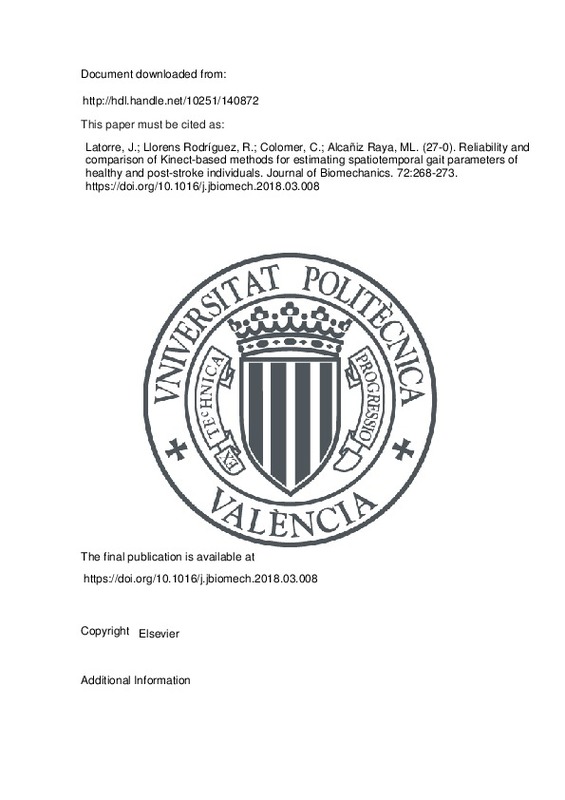JavaScript is disabled for your browser. Some features of this site may not work without it.
Buscar en RiuNet
Listar
Mi cuenta
Estadísticas
Ayuda RiuNet
Admin. UPV
Reliability and comparison of Kinect-based methods for estimating spatiotemporal gait parameters of healthy and post-stroke individuals
Mostrar el registro sencillo del ítem
Ficheros en el ítem
| dc.contributor.author | Latorre, Jorge
|
es_ES |
| dc.contributor.author | Llorens Rodríguez, Roberto
|
es_ES |
| dc.contributor.author | Colomer, Carolina
|
es_ES |
| dc.contributor.author | Alcañiz Raya, Mariano Luis
|
es_ES |
| dc.date.accessioned | 2020-04-17T12:49:11Z | |
| dc.date.available | 2020-04-17T12:49:11Z | |
| dc.date.issued | 2018-04-27 | es_ES |
| dc.identifier.issn | 0021-9290 | es_ES |
| dc.identifier.uri | http://hdl.handle.net/10251/140872 | |
| dc.description.abstract | [EN] Different studies have analyzed the potential of the off-the-shelf Microsoft Kinect, in its different versions, to estimate spatiotemporal gait parameters as a portable markerless low-cost alternative to laboratory grade systems. However, variability in populations, measures, and methodologies prevents accurate comparison of the results. The objective of this study was to determine and compare the reliability of the existing Kinect-based methods to estimate spatiotemporal gait parameters in healthy and post-stroke adults. Forty-five healthy individuals and thirty-eight stroke survivors participated in this study. Participants walked five meters at a comfortable speed and their spatiotemporal gait parameters were estimated from the data retrieved by a Kinect v2, using the most common methods in the literature, and by visual inspection of the videotaped performance. Errors between both estimations were computed. For both healthy and post-stroke participants, highest accuracy was obtained when using the speed of the ankles to estimate gait speed (3.6¿5.5 cm/s), stride length (2.5¿5.5 cm), and stride time (about 45 ms), and when using the distance between the sacrum and the ankles and toes to estimate double support time (about 65 ms) and swing time (60¿90 ms). Although the accuracy of these methods is limited, these measures could occasionally complement traditional tools. | es_ES |
| dc.description.sponsorship | This work was supported by Universitat Politecnica de Valencia (Grant PAID-10-16) and Fundacio La Marato de la TV3 (Project VALORA). | es_ES |
| dc.language | Inglés | es_ES |
| dc.publisher | Elsevier | es_ES |
| dc.relation.ispartof | Journal of Biomechanics | es_ES |
| dc.rights | Reserva de todos los derechos | es_ES |
| dc.subject | Stroke | es_ES |
| dc.subject | Gait | es_ES |
| dc.subject | Spatiotemporal | es_ES |
| dc.subject | Biomechanics | es_ES |
| dc.subject | Kinect v2 | es_ES |
| dc.subject.classification | TEORIA DE LA SEÑAL Y COMUNICACIONES | es_ES |
| dc.subject.classification | EXPRESION GRAFICA EN LA INGENIERIA | es_ES |
| dc.title | Reliability and comparison of Kinect-based methods for estimating spatiotemporal gait parameters of healthy and post-stroke individuals | es_ES |
| dc.type | Artículo | es_ES |
| dc.identifier.doi | 10.1016/j.jbiomech.2018.03.008 | es_ES |
| dc.relation.projectID | info:eu-repo/grantAgreement/UPV//PAID-10-16/ | es_ES |
| dc.rights.accessRights | Abierto | es_ES |
| dc.contributor.affiliation | Universitat Politècnica de València. Departamento de Ingeniería Gráfica - Departament d'Enginyeria Gràfica | es_ES |
| dc.description.bibliographicCitation | Latorre, J.; Llorens Rodríguez, R.; Colomer, C.; Alcañiz Raya, ML. (2018). Reliability and comparison of Kinect-based methods for estimating spatiotemporal gait parameters of healthy and post-stroke individuals. Journal of Biomechanics. 72:268-273. https://doi.org/10.1016/j.jbiomech.2018.03.008 | es_ES |
| dc.description.accrualMethod | S | es_ES |
| dc.relation.publisherversion | https://doi.org/10.1016/j.jbiomech.2018.03.008 | es_ES |
| dc.description.upvformatpinicio | 268 | es_ES |
| dc.description.upvformatpfin | 273 | es_ES |
| dc.type.version | info:eu-repo/semantics/publishedVersion | es_ES |
| dc.description.volume | 72 | es_ES |
| dc.relation.pasarela | S\358838 | es_ES |
| dc.contributor.funder | Fundació La Marató de TV3 | es_ES |
| dc.contributor.funder | Universitat Politècnica de València | es_ES |







![[Cerrado]](/themes/UPV/images/candado.png)

